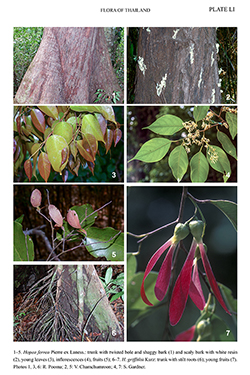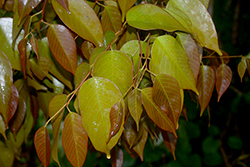e-Flora of Thailand
Volume 13 > Part 4 > Year 2017 > Page 598 > Dipterocarpaceae > Hopea
4. Hopea ferrea Pierre ex Laness.wfo-0000724531
Pl. Util. Col. Franc.: 300. 1886; Pierre, Fl. Forest. Cochinch. 3: pl. 249. 1891; Smitinand, Santisuk & Phengklai, Thai Forest Bull., Bot. 12: 46. 1980; P.S.Ashton, Fl. Males., Ser. 1, Spermat. 9: 421. 1982; Smitinand, J.E.Vidal & P.H.Hô, Fl. Cambodge, Laos & Vietnam 25: 72, t. 12, figs. 6–11. 1990; Svengs. & J.E.Vidal, Diptérocarp. Laos: 26. 1997; Pooma & M.F.Newman, Thai Forest Bull., Bot. 29: 142. 2001; Symington, P.S.Ashton & S.Appanah, Malayan Forest Rec. 16: 293. 2004; Gardner, Sidisunthorn & Chayamarit, Forest Trees S. Thailand Vol. 1: 435, fig. 661. 2015. Plate LI: 1–5.
Accepted Name : This is currently accepted.
Synonyms & Citations :
Description : Tree, 10–30 m tall, bole frequently twisted; bark smooth, becoming shaggy or scaly; most parts glabrous. Buds minute. Twigs lenticellate. Stipules elliptic, ca 1 mm long. Leaves thinly coriaceous, ovate to ovate-oblong, 4–10 by 2.5–5 cm; base broadly cuneate to rounded, more or less asymmetrical, slightly peltate or cordate in seedling; apex acuminate, to 1.5 cm long; nervation scalariform, main nerves 8–10 on each side; domatia gland-like, glabrous; tertiary nerves densely scalariform; midrib slightly depressed or flattened above; petioles 0.8–1.3 cm long. Inflorescences 3.5–7 cm long, densely pubescent, singly branched; branchlets to 4 cm long, bearing 3–10 flowers; flower buds subglobose to broadly ovoid, 2–3 by 1.5–2 mm, subsessile. Calyx lobes broadly ovate, ca 1–1.5 by 1 mm, apex acute, densely pubescent outside. Petals obovate-oblong, 2–3 by 1–1.5 mm, pale yellow, cream or white. Stamens 15, in 2 whorls; filaments 1–1.7 mm long; anthers subglobose, 0.3–0.4 mm long; connective-appendages ca as long as anthers. Ovary and stylopodium pyriform, 1.3–2 by 0.8–1 mm, glabrous or punctate; stylopodium stout, 0.3–0.5 mm long, attenuate below stigma. Fruiting calyx lobes glabrous to sparsely pubescent; 2 lobes wing-like, 2.5–4 by 0.7–1.8 cm, base narrow, thickened, 4–10 by 1–2 mm, light green or yellowish green when young; 3 shorter lobes oblong to lanceolate, 2.5–4 by 1 mm; fruit pedicels 1–2 mm long. Nut fusiform, 0.7–1.4 by 0.2–0.4 cm, tapering abruptly to stylopodium remnant, frequently resinous; stylopodium remnant ca 1 mm long.
Thailand : NORTHERN: Nakhon Sawan (Phaisali); NORTH-EASTERN: Phetchabun, Loei, Bueng Kan, Nakhon Phanom, Sakon Nakhon, Khon Kaen; EASTERN: Chaiyaphum, Nakhon Ratchasima, Buri Ram, Si Sa Ket, Ubon Ratchathani; SOUTH-EASTERN: Chachoengsao, Chanthaburi; CENTRAL: Lop Buri; PENINSULAR: Surat Thani, Krabi, Nakhon Si Thammarat, Phatthalung, Trang, Satun, Songkhla.
Distribution : Laos, Cambodia, S Vietnam (type), Upper Peninsular Malaysia.
Ecology : Dry evergreen forests, occasionally found by streams in deciduous forests, in the Peninsular most commonly occurring on limestone hills, to 900 m alt. Flowering: August–December; fruiting: December–May.
Vernacular : Takhian hin (ตะเคียนหิน); khaen (แคน), khaen hin (แคนหิน)(Northeastern); takhian nu (ตะเคียนหนู)(Nakhon Ratchasima); lao tao (เหลาเตา), khian sai (เคียนทราย)(Peninsular).
E-version notes : As Hopea ferrea Laness.



